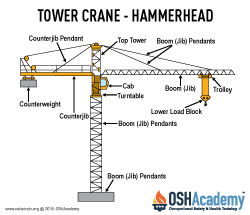Crane Types
Tower cranes: Lifting structures which utilize a vertical mast or tower to support a working boom (jib) in an elevated position. Loads are suspended from the working boom. While the working boom may be of the fixed type (horizontal or angled) or have luffing capability, it can always rotate to swing loads, either by rotating on the top of the tower (top slewing) or by the rotation of the tower (bottom slewing). The tower base may be fixed in one location or ballasted and moveable between locations. Tower cranes include those with a fixed jib (hammerhead boom), those with a luffing boom, and self-erecting tower cranes.
Articulating cranes: Also known as knuckle-boom cranes and loader cranes. These are cranes whose boom consists of a series of folding, pin-connected structural members, typically manipulated to extend or retract by power from hydraulic cylinders.
All derricks (except for gin poles used for the erection of communication towers): This crane is composed of a tower that does not bend but instead pivots at the base. The tower is usually composed of crisscrossing steel pipes and braces. This gives the crane a great deal of strength using very little structure. Four lines are connected to the tower; the crane tower can move in every direction because the lines are independent of one another. Hanging over the end of the tower is a single fifth line that has a hook or other attachment on the end. This fifth line moves up and down and attaches to loads.
Knowledge Check Choose the best answer for the question.
1-2. Which of the following cranes have booms that consist of a series of folding, pin-connected structural members?
You forgot to answer the question!


